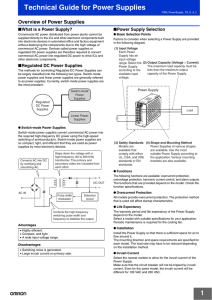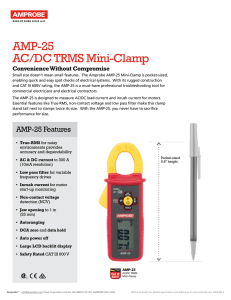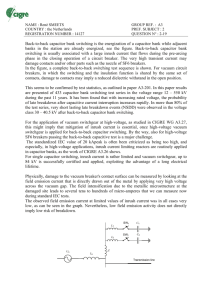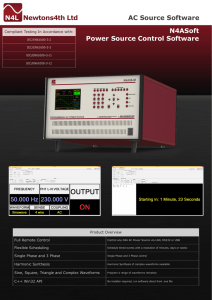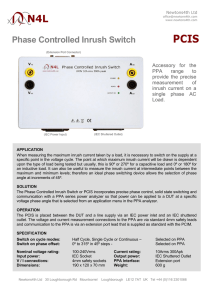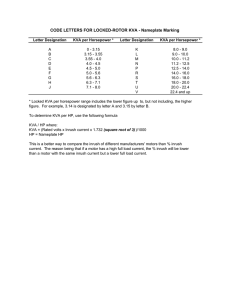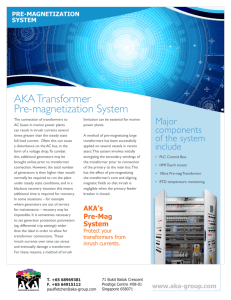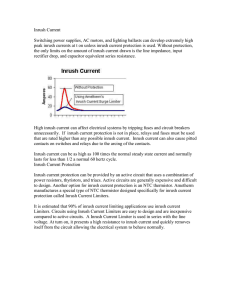Technical Bulletin
advertisement
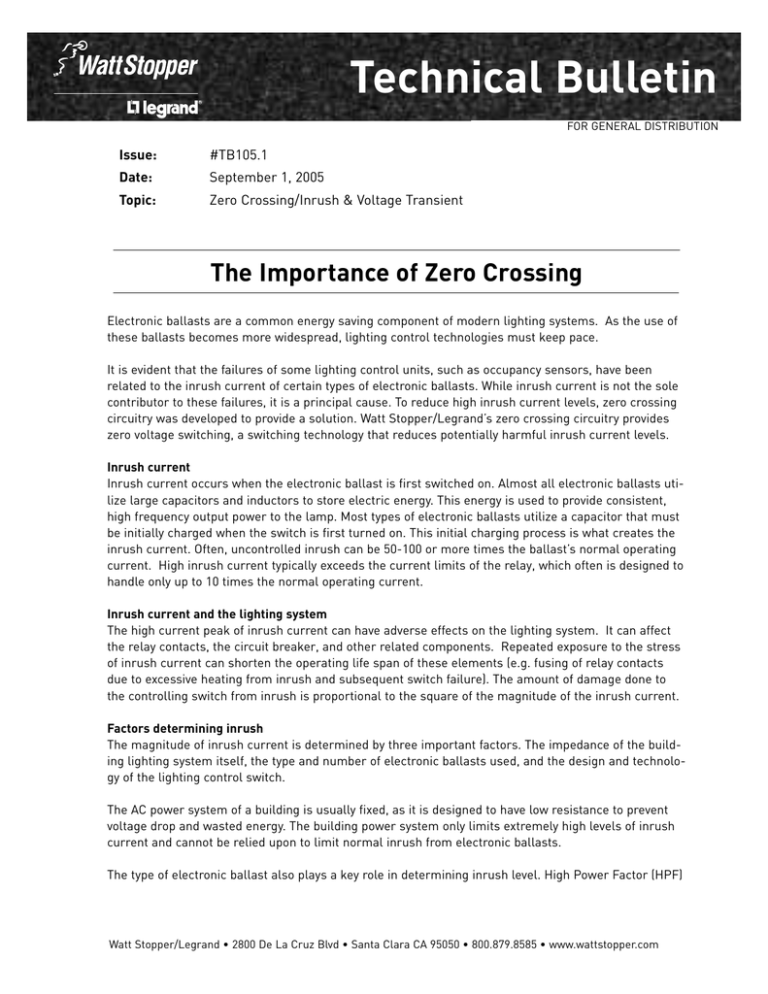
Technical Bulletin FOR GENERAL DISTRIBUTION Issue: #TB105.1 Date: September 1, 2005 Topic: Zero Crossing/Inrush & Voltage Transient The Importance of Zero Crossing Electronic ballasts are a common energy saving component of modern lighting systems. As the use of these ballasts becomes more widespread, lighting control technologies must keep pace. It is evident that the failures of some lighting control units, such as occupancy sensors, have been related to the inrush current of certain types of electronic ballasts. While inrush current is not the sole contributor to these failures, it is a principal cause. To reduce high inrush current levels, zero crossing circuitry was developed to provide a solution. Watt Stopper/Legrand’s zero crossing circuitry provides zero voltage switching, a switching technology that reduces potentially harmful inrush current levels. Inrush current Inrush current occurs when the electronic ballast is first switched on. Almost all electronic ballasts utilize large capacitors and inductors to store electric energy. This energy is used to provide consistent, high frequency output power to the lamp. Most types of electronic ballasts utilize a capacitor that must be initially charged when the switch is first turned on. This initial charging process is what creates the inrush current. Often, uncontrolled inrush can be 50-100 or more times the ballast’s normal operating current. High inrush current typically exceeds the current limits of the relay, which often is designed to handle only up to 10 times the normal operating current. Inrush current and the lighting system The high current peak of inrush current can have adverse effects on the lighting system. It can affect the relay contacts, the circuit breaker, and other related components. Repeated exposure to the stress of inrush current can shorten the operating life span of these elements (e.g. fusing of relay contacts due to excessive heating from inrush and subsequent switch failure). The amount of damage done to the controlling switch from inrush is proportional to the square of the magnitude of the inrush current. Factors determining inrush The magnitude of inrush current is determined by three important factors. The impedance of the building lighting system itself, the type and number of electronic ballasts used, and the design and technology of the lighting control switch. The AC power system of a building is usually fixed, as it is designed to have low resistance to prevent voltage drop and wasted energy. The building power system only limits extremely high levels of inrush current and cannot be relied upon to limit normal inrush from electronic ballasts. The type of electronic ballast also plays a key role in determining inrush level. High Power Factor (HPF) Watt Stopper/Legrand • 2800 De La Cruz Blvd • Santa Clara CA 95050 • 800.879.8585 • www.wattstopper.com Watt Stopper/Legrand Technical Bulletin Issue: #TB105.1 • Date: September 1, 2005 ballasts are the most common electronic ballasts used. High power factor electronic ballasts consist of active and passive power factor correction models. Both use electrolytic capacitors that generate inrush current. Low power factor (LPF) ballasts, used with compact fluorescent lamps (CFLs), have a similar capacitor and also experience high levels of inrush current. Lighting control technology and design also affects the inrush level in a lighting system and can be practical for preventing potential inrush problems. The components of the switch, including the relay contact design and contact closure time are important elements of determining inrush capability. Zero crossing circuitry represents a means for reducing the negative effects of inrush levels through technology at the control level. Theoretical background & ballast technology Before describing the effects of zero crossing circuitry on inrush, it is important to clarify certain fundamental concepts. Zero crossing circuitry, which provides zero voltage switching, works because of the condition of AC power. AC power is transient and not sinusoidal steady state during the initial switching. This assumption sets up the condition for zero voltage switching to reduce inrush current, as demonstrated with proven empirical and computer model data. Active power correction In active power factor correction ballasts, the capacitor is in a series circuit that consists of a fast rectifier, a “boost” inductor, a full-wave rectifier, and the two-winding EMI filter inductor. This can be expressed as a three component series circuit. The components of the circuit are a single inductor (L) equal to the sum of the boost inductor and the leakage inductance of the EMI inductor, a resistor (R) equal to the sum of the inductors’ winding resistances, and the electrolytic capacitor (C). The series L-R-C circuit of this type will have a basic half-period (T) equal to π times the square root of the product of L and C. In addition, the “characteristic impedance” (Z) of the L and C is equal to square root of L over C. 277V Active Power Factor ballast model Basic Half-period: T = π (LC)1/2 Characteristic Impedance: Z = (L/C)1/2 If T is small compared to the half time period of 60Hz (8.33mS), and the AC voltage is relatively stable, then a good approximation of the peak current to charge the capacitor is denoted by the voltage (V) at the instant of turn-on divided by (Z + R). The peak current is inrush current. Peak Current (Inrush Current): Ip = V Z+R Theory then shows that inrush current when the AC voltage line is near its peak will be many times higher than the inrush near zero voltage. Any inrush that still exists near zero voltage is caused by the fact that AC voltage does not remain at zero, and, as the voltage rises, the capacitor starts charging. Passive power factor correction The passive power factor corrected ballasts possess a similar L-R-C circuit as the active ballasts, yet the Watt Stopper/Legrand • 2800 De La Cruz Blvd • Santa Clara CA 95050 • 800.879.8585 • www.wattstopper.com Watt Stopper/Legrand Technical Bulletin Issue: #TB105.1 • Date: September 1, 2005 values of the components are different. With passive power factor, the value for L (inductor and leakage impedance) is hundreds of times larger than the active power factor ballast’s L. A larger value for L means a longer half-period time T and a lower peak current. The much larger L means a much higher Z, and thus a many times lower inrush current. Even at the phase angle for the worst case of inrush, the amount of inrush generated by the passive power factor ballast is minimal. 277V Passive Power Factor ballast model Low power factor The most common use for low power factor ballasts (less than 30 watts) has been for compact fluorescent lamps. In low power factor ballasts, the capacitor is charged from a full-wave rectifier directly from the AC line. A small EMI series inductor is used, with the L in the L-R-C series much smaller than active power factor ballasts. The C is also smaller, due to the lower wattage. As with the active ballasts, the maximum inrush occurs near the peak of the AC line. 277V Low Power Factor ballast model Based on the component values of the L-R-C series circuit in both the active and low power ballasts and basic electronics theory, the maximum inrush can be expected when the AC voltage line is near its peak, and that inrush will be substantially less for zero voltage switching. Zero crossing circuitry and inrush Zero crossing circuitry provides zero-voltage switching capability. Normal switching occurs at random points along the AC voltage line. Statistically, a significant number of inrush current peaks occur at or near worst-case. Zero voltage switching is synchronized to the AC voltage, so that switching occurs at or near zero volts. Switching at or near zero volts will ensure minimized inrush current and increased operational life of the lighting control components. With zero voltage switching, each switch event will have the same low inrush current. Inrush Current Levels Inrush Current (Amps) 35 30 25 20 75 Degrees 15 90 Degrees Zero-voltage 10 5 0 Active PFC Passive PFC Low PFC Phase Angle Watt Stopper/Legrand • 2800 De La Cruz Blvd • Santa Clara CA 95050 • 800.879.8585 • www.wattstopper.com Watt Stopper/Legrand Technical Bulletin Issue: #TB105.1 • Date: September 1, 2005 Computer model simulations, as well as actual ballasts measurements have demonstrated that zero voltage switching could reduce inrush generated by multiple ballasts by a factor of four or five. Zero voltage switching substantially reduced inrush in all active power factor ballasts tested from the 75 to 90 degree phase angle cases. Passive power factor ballasts, which typically have low inrush levels, keep inrush current low regardless of phase angle. Zero crossing and voltage transients Another potential hazard to the lighting system are the voltage transients. The voltage transient is caused by the interruption of the current flowing in the electronic ballast’s inductor at switch-off. The transient energy can potentially be over 1000 volts. The actual amount of voltage depends, like inrush, on a number of system factors, but is proportional to the amount of inductance and the current in the inductor at switch off. Voltage transients can arc through wire insulation, to other wires or even the ballast or ballast inductor. Arcing such as this will eventually destroy part of the lighting system. Electronic ballasts with passive power factor designs, by virtue of their large inductors, have the highest potential risk for switch-off voltage transients. Because the wave form is mostly sinusoidal and high power factor, the AC current is for the most part in phase with the AC voltage. If a zero voltage switch is employed, the voltage will be switched off at or near zero and the AC current will thus be at or near zero. Zero voltage switching thus allows only very low transient voltages to occur at switch off. Conclusions The use of certain types of electronic ballasts exposes the lighting system to the effects of inrush current and voltage transients. These two phenomena, both products of the design and function of the electronic ballast, have the potential to do damage to the components of the lighting control as well as the ballast and other parts of the lighting system. Zero voltage switching, as evident from testing and computer modeling, minimizes the effects of inrush current and transient arcing throughout the lighting system. • Active power correction and low power factor ballasts both exhibit high levels of inrush current. Zero crossing circuitry reduces the effects of inrush by switching when AC voltage is at or near zero, preventing damage from the AC current that can occur during the inrush current “spike.” • Passive power correction ballasts, while not generating a damaging amount of inrush current, possess a greater risk for voltage transient arcing during switch off. This arcing can damage not only elements of the relay but can also harm the ballast as well. By switching off at or near zero voltage, the risk of voltage transients is greatly reduced. Watt Stopper’s zero crossing circuitry, through zero voltage switching, provides longer operational product life and improved reliability for lighting control devices, as well as protection for the rest of the lighting system from the stress of repeated exposure to inrush current and voltage transients. Refer to Technical Bulletins TB 106.1 and 107.1 for further discussion of inrush and zero crossing. Watt Stopper/Legrand • 2800 De La Cruz Blvd • Santa Clara CA 95050 • 800.879.8585 • www.wattstopper.com Watt Stopper/Legrand Technical Bulletin Issue: #TB105.1 • Date: September 1, 2005 Actual Ballast Measurement - 2 Lamp, 277V Inrush Current at 90˚ Phase Angle 35.4A at approx. 400V Amps 30 20 10 2 4 6 8 msec Inrush Current at 0˚ Phase Angle Amps 10 3.48A at approx. zero V 5 2 4 6 8 msec Watt Stopper/Legrand • 2800 De La Cruz Blvd • Santa Clara CA 95050 • 800.879.8585 • www.wattstopper.com
